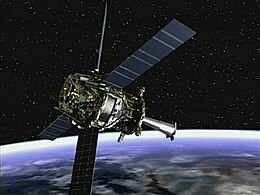Gravity Probe B
 |
|
| Mission type | Astrophysics |
|---|---|
| Operator | NASA/Stanford University |
| COSPAR ID | 2004-014A |
| SATCAT no. | 28230 |
| Website | einstein |
| Mission duration | 17.5 months |
| Spacecraft properties | |
| Manufacturer | Lockheed Martin |
| Launch mass | 3,100 kg (6,800 lb) |
| Dimensions | 6.4 m × 2.6 m (21.0 ft × 8.5 ft) |
| Power | 606 W Spacecraft: 293 W Payload: 313 W |
| Start of mission | |
| Launch date | 20 April 2004, 16:57:24 UTC |
| Rocket | Delta II 7920-10C |
| Launch site | Vandenberg SLC-2W |
| End of mission | |
| Disposal | Decommissioned |
| Deactivated | 8 December 2010 |
| Orbital parameters | |
| Reference system | Geocentric |
| Regime | Low Earth |
| Semi-major axis | 7,027.4 km (4,366.6 mi) |
| Eccentricity | 0.0014 |
| Perigee | 641 km (398 mi) |
| Apogee | 645 km (401 mi) |
| Inclination | 90.007º |
| Period | 97.65′ |
| Epoch | UTC |
Gravity Probe B (GP-B) was a satellite-based mission which launched on 20 April 2004 on a Delta II rocket. The spaceflight phase lasted until ; its aim was to measure spacetime curvature near Earth, and thereby the stress–energy tensor (which is related to the distribution and the motion of matter in space) in and near Earth. This provided a test of general relativity, gravitomagnetism and related models. The principal investigator was Francis Everitt.
Initial results confirmed the expected geodetic effect to an accuracy of about 1%. The expected frame-dragging effect was similar in magnitude to the current noise level (the noise being dominated by initially unmodeled effects due to nonuniform coatings on the gyroscopes). Work continued to model and account for these sources of error, thus permitting extraction of the frame-dragging signal. By , the frame-dragging effect had been confirmed to within 15% of the expected result, and the NASA report indicated that the geodetic effect was confirmed to better than 0.5%.
In an article published in the journal Physical Review Letters in , the authors reported analysis of the data from all four gyroscopes results in a geodetic drift rate of −6601.8±18.3 mas/yr and a frame-dragging drift rate of −37.2±7.2 mas/yr, in good agreement with the general relativity predictions of −6606.1±0.28% mas/yr and −39.2±0.19% mas/yr, respectively.
...
Wikipedia
